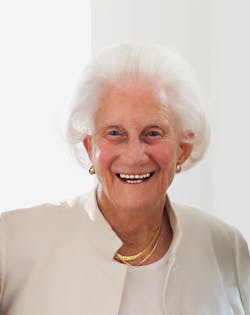“One of my favorite questions I like to ask, particularly to men, but also women: Can you name five women architects?” - Beverly Willis
Beverly Willis, FAIA, started our conversation with that query, and I’m embarrassed that it takes a moment for me to respond. Willis is used to the pauses and moments of recollection to this question; it happens quite often. She then went on to explain that keeping women from the architectural history books has had consequences.
“One of [the Beverly Willis Architectural Foundation’s] major founding principles was to see women are referenced in the architectural history books,” she said. “As of now, with the exception of maybe Jane Jacobs and perhaps one other, there are no references to women in the architectural history books. Of course from an educational standpoint, that’s pretty devastating because that means that each generation of women architects who take architectural history in high school and college do not read about other women architects. They’re robbed of role models and they’re robbed of the rich history of architecture, design, and—in general—the many aspects of the building industry.”
Paving a New Path With History
Beverly Willis knows the history of architecture and design in a more personal way than most. The 90-year-old has been pushing boundaries her entire life, studying engineering at Oregon State University from 1946 to 1948 and later receiving her Bachelor of Fine Arts degree in 1954 from the University of Hawaii. This early work as a multi-media artist opened the door to designing retail stores; which lead to designing large-scale housing; which lead to designs for institutions and urban planning, publishing books, curating exhibitions, and creating films.
This is how Beverly Willis' awe-inspiring career has played out: building each experience upon another and being willing to do the next thing to come her way. It isn’t the typical architectural career, which she pointed out is a byproduct of her art background.
“My art has really informed my whole life—my architectural career,” Beverly Willis explained. “I didn’t go to architectural school, I just have a degree in art. I’m a licensed architect, mind you, but as an artist, I think that I tend to do things a little bit out of the box. I’m not so constrained as somebody who has been schooled in a long tradition of following different architects from decade to decade.”
One of Beverly Willis’ first experiences thinking outside the box was in considering reusing old buildings in the post-war period, which was unheard of in those days. “Up until that point, you just tore buildings down and you built new buildings. You didn’t keep any old buildings. You bulldozed them down and built a new building.
“Well, I was hired to do this project,” Willis continued. “The owners thought to tear the building down and build a new one. That was my instructions. But the problem was, there wasn’t enough land to meet the parking requirements by the city. It was sort of a dilemma. We couldn’t build a new building because we didn’t have enough land to build both [the building and the parking lot] and be an economically feasible retail building. I came up with this idea to reuse the building.”
Adaptive Reuse
The result was the reuse of three Victorian buildings by raising them and adding a combined street-level floor beneath—one of the first examples of adaptive reuse as it is widely known today. “I was motivated by trying to solve a problem that existed, but by the same token, not thinking about ‘I’m going to go out and create a national movement whereby people can actually readapt older buildings into something useful without tearing it down.’”
In 2000, after 35 years of leading her own architectural practice, Willis contacted architectural historians Diane Favro, Ph.D., and Lian Mann, Ph.D., who shared her concern for the lack of representation of women in the architectural history books. Joined later by Heidi Gifford, the quartette began the research that would become the Beverly Willis Architectural Foundation (BWAF) in 2002. The nonprofit 501 ©(3) organization is a research entity, Willis stresses, which both curates and commissions studies in relation to women working in the building industry, including within architecture, engineering, construction, design, landscape, preservation, and planning.
International Women's Day Spotlight: Between Craft and Industry
Most recently, BWAF has been in the spotlight for its panel discussion relating to architecture and the #MeToo movement, as well as the release of Willis’ fifth film, Unknown New York: The City That Women Built, in May 2018. She spoke with passion during our conversation when stating that the problem of sexual harassment is one that needs to be addressed—that while architecture programs see attendance split nearly 50-50 between male and female, you find a sharp decrease in female practitioners, particularly the higher up the corporate ladder you go—and about the release of Unknown New York.
The final 20-minute documentary focuses on 234 select Manhattan projects that were designed, engineered, or developed by women. Of the accompanying map that was created for the film, Willis said “Creating the map caused you to see that the city is blanketed in women’s work.”
Beverly Willis, it seemed during our discussion, is unaware that the average person begins to slow down around age 60, not to mention 90 years old; but then again, Beverly Willis has never been a typical person. She is rewriting architectural history through her legacy.
About the Author

Kadie Yale
Former Editor-in-Chief
Kadie Yale holds a BA in Industrial Design from San Francisco State University and a MA in Decorative Art History and Theory from Parsons the New School. In her role as editor-in-chief from 2015-2018, she led the interiors+sources team in creating relevant content that touches on sustainability, universal design, science, and the role of design in society.

